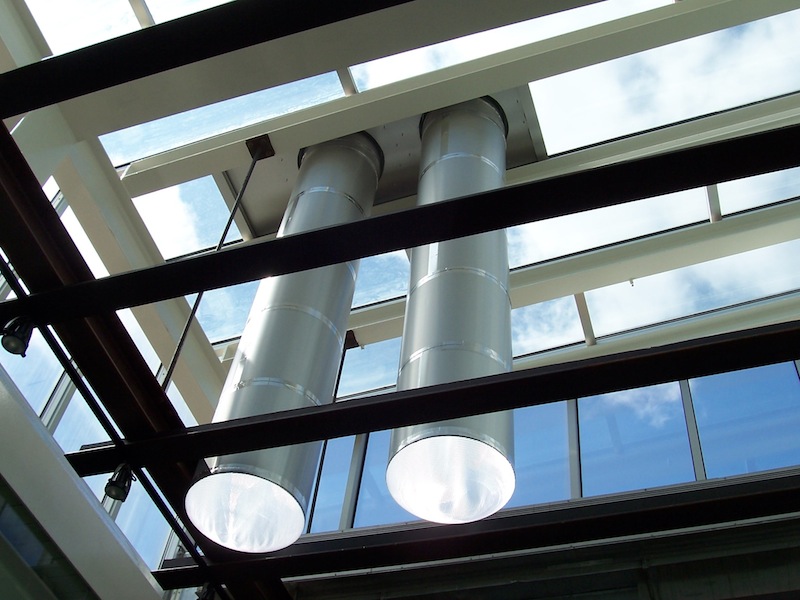
News
FEATURE – Facts and Figures – Making the Case for Daylighting
January 11, 2012 - The value of energy savings from daylighting is far overshadowed by the value of the predicted increase in sales due to daylighting. By the most conservative estimate, the profit from increased sales associated with daylight is worth at least 19 times more than the energy savings.
January 11, 2012 By Solatube

Natural lighting for outdoor gear and clothing retailer REI helped the store realize a 26% reduction in energy usage.
The Federal Energy Management Program reports that 25% to 50% energy savings can be achieved with advanced lighting equipment; that number can be cut in half when daylighting is added to the project.
The savings in energy from daylighting are so demonstrably significant that the revised California building code, Title 24, requires every large-space big-box retailer, warehouse or low-rise facility with an area greater than 25,000 sf directly under a roof with ceiling heights greater than 15 feet and a lighting power density greater than 0.5 W/sf to light at least 50% of the area with daylight.
The U.S. Department of Energy’s (DoE’s) Federal Energy Management Program reports daylighting can significantly cut lighting energy use for lighting building interiors—sometimes by up to 75% or 80%. DoE’s Renewable Energy Laboratory’s Thermal Test Facility in Golden, Colo., was designed to provide natural lighting, allowing it to use 75% less energy for lighting than a building without this feature. Except for the central service area, the facility is entirely daylit, which has also decreased the energy load imposed on the building’s mechanical cooling system. DoE reports that the total energy costs for many commercial buildings can be reduced by as much as one-third through the optimal use of daylighting strategies.
According to the Lighting Research Center at Rensselalaer Polytechnic Institute in Troy, N.Y., a sample calculation shows energy costs saved per year can be about $0.25/sf of daylit floor area. (This assumes there are 260 working days per year, electricity costs of $0.10/kWh, the daylighting system turns off the lights five hours per day, and the connected lighting load is 2 W/sf.)
According to the Wisconsin Daylighting Collaborative, about 86% of electricity in traditional buildings goes for light, fans and cooling. A cool daylighting project can cut these costs by more than 50% by reducing electric lighting, because daylight produces less heat per unit of illumination than most light sources. The collaborative also notes the demand savings are more important than the energy savings since daylighting provides energy usage reduction at the most important time: peak hours, when energy rates are the highest and daylight availability is the greatest.
The Florida Energy Conservation Assistance Program reported that 29 Florida businesses that installed daylighting systems reduced daytime electric lighting consumption by an average of 93% while still achieving an average of 160 fc of light with a colour rendering index (CRI) of 98 in work areas.
The Utah State Department of Natural Resources office building in Salt Lake City utilizes daylighting as an integral part of an energy-efficient design that reduces lighting load by 51% and saves $50,000 a year over a reference-case building.
A daylighting test at the Federal Office Building in Oakland, Calif., reported up to 86% lighting energy savings and a daily cooling load reduction of up to 24%, along with higher worker satisfaction.
According to BetterBricks Daylighting Lab in Seattle, Wash., the majority of commercial space in the United States is either one-storey or within 25 ft of an exterior wall. This means that nearly every commercial building is a potential daylighting project. By combining daylighting with efficient florescent lighting and dimmers, 75% of lighting energy consumption can often be saved.
Outdoor gear manufacturer Patagonia, based in Reno, Nev., built its distribution facility to include skylights and lighting controls to conserve energy. The company reports the lighting system in its distribution centre is 30% more efficient than the standard centre in terms of total energy consumption. The catalogue-company realized a return on investment in just three years.
According to the U.S. Green Building Council’s Sustainable Building Technical Manual, well-designed daylighting can reduce lighting energy use by 50% to 80%.
 NASA’s Ames Research Center in Moffett Field, Calif., underwent an energy-savings campaign in 2001 that included turning off lights to take advantage of natural light. As a result, energy costs were reduced by $30,000 to $65,000 a month.
NASA’s Ames Research Center in Moffett Field, Calif., underwent an energy-savings campaign in 2001 that included turning off lights to take advantage of natural light. As a result, energy costs were reduced by $30,000 to $65,000 a month.
At Solatube International’s headquarters in Vista, Calif., a retrofit to include 21-in. Solatube units has resulted in an 86.1% reduction in lighting costs for the daylit portion of the office, and a 68.2% reduction for the warehouse area.
Lockheed Martin reports that, after daylighting its facility in Sunnyvale, Calif., the company reaped annual energy savings of $500,000 (about 75% of its electric bill), plus 15% higher worker productivity.
Florida’s Energy Conservation Assistance Program (ECAP) reports that 29 Florida businesses that installed daylighting systems with the organization’s help reduced daytime electric lighting consumption by an average of 93% while still achieving an average of 160 fc of light with a CRI index of 98 at work surfaces.
According to the Sustainable Building Industries Council in Washington, D.C., the average middle school that incorporates daylighting will save $500,000 over the next 10 years.
Researchers at the Lawrence Berkeley National Laboratory in Berkeley, Calif., reported the use of daylighting techniques in the retrofit of the single-storey Palm Springs Chamber of Commerce resulted in reduced annual electricity consumption of 47%. Additionally, the daylighting retrofit was met with positive feedback from the building’s occupants, many who were often able to work with no electrical lighting at all.
According to the California Public Utilities Commission’s Energy Design Resources website, an average grocery store could save about $16,000 a year (or $0.32/sf in operating costs) by utilizing skylights. A typical school could save $7500 per year ($0.23/sf) while an industrial building could save about $0.12/sf.
In the Netherlands, ING Bank built a new headquarters designed to favour natural lighting. Since opening in 1987, the bank has used 92% less energy than an adjacent bank constructed at the same time, saving the owner $2.9 million a year.
— With files and photo courtesy Solatube
Print this page